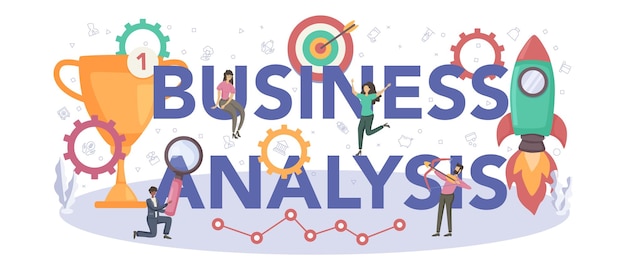Business analysis is very critical to smoothen operations, enhance decision-making, and ultimately drive business growth. The use of the right tools and methodologies is necessary for great business analysis. They are used to support analysts within the organization during data collection, process modeling, and actionable insight building. The efficiency and accuracy of the analysis are highly determined by the choice of tools.
Key Business Analysis Methodologies
- Waterfall Model: Known as the first development methodology, used generally as a high-level project management methodology. The waterfall model shows a process for software development in a linear sequential flow. This means that any phase in the development process begins only if the previous phase is complete. In this waterfall model, the phases do not overlap.
- Agile Methodology: a project management approach that involves breaking the project into phases and emphasizes continuous collaboration and improvement.
- Lean: Lean methodology is all about optimizing people, resources, efforts, and energies in the organization toward the creation of value for the customer. The lean methodology seeks to maximize the process and output of your team by continuous improvements.
Essential Business Analysis Techniques
- SWOT Analysis: A SWOT analysis is a leading tool for strategic planning, which helps identify the different consistencies of your business in terms of strengths, weaknesses, opportunities, and threats. It may turn out useful in several ways: It helps to look at your business from another perspective; it takes a look at your business from more directions than one can. It helps you make or fine-tune your business strategy.
- PEST Analysis: It is simply the learning about one’s business operating environment in terms of political, economic, socio-cultural, and technological factors that impact the business. This would therefore imply that it is a strategic tool designed to understand the market growth or decline, positioning of the business, its potential and direction of operation.
- MOST Analysis: MOST stands for mission, objectives, strategies, and tactics. MOST analysis gives an analysis of the organization’s internal environment, which enhances the internal processes and company culture. MOST analysis is pretty solid, and very often it empowers business enterprises with new capability and purpose.
- Root Cause Analysis: RCA is the method that allows the origin or cause of a problem to be identified and finds a solution that will treat it at its root or source. This provides a mechanism whereby organizations and professionals can work toward looking beyond the symptoms of the problem to where the real cause exists.
- Use Case Analysis: The use case is a very broad concept used in the software development life cycle and product design, as well as in general engineering centers, for understanding how a system can be used to achieve particular goals or execute some tasks. It outlines an interaction between some users or other actors and the system under consideration to bring about a specific result.
Top Business Analysis Tools
- Microsoft Excel: Data analysts use this tool for formatting, organizing, and calculating data in a spreadsheet. Organizing data in this manner allows information to become easier to view when data is added or changed with a program like Excel.
- Tableau: Tableau is designed to make data easy for data analysts to visualize and understand. You basically only need to connect to virtually any database, drag and drop to see your data, and share it with just a click. Data analysts use it for building shareable and interactive dashboards.
- Power BI: Power BI is actually a suite of business analytics services that deliver insights to enable fast, informed decisions. Power BI dashboards and reports are live, interactive, and contain visualizations and KPIs from data sitting both on-premise and in the cloud so that you will have a live monitoring view all over your business domain in real-time. In simple words, it helps you discover your data through drag-and-drop exploration and interactive visualizations with Power BI Desktop, publishing to Power BI.
- JIRA: used by teams for planning, tracking, releasing, and supporting world-class software with confidence. It’s a single source of truth for your whole development lifecycle that empowers autonomous teams with the context to move quickly while staying connected to the greater business goal.
- Balsamiq Mockups: This is another nice wireframing tool from Sustain that helps to enable the user to quickly and easily draw sketches of software interfaces.
- Lucidchart: This solves complex problems visually by building architectural diagrams and flowcharts. It increases clarity and ramps up everybody on the team quickly regarding a codebase and systems with a distributed team.
- Visio: Used for drawing different types of diagrams, flowcharts, org charts, building plans, floor plans, data flow diagrams, and process flow diagrams on business process modeling.
- Minitab: Minitab has all the tools that will be needed to analyze your data effectively. Guiding through the right analysis and giving clear results, Minitab enables one to find meaningful solutions for the toughest problems in their business.
- Confluence: a collaboration tool that integrates with Confluence for the documentation of requirements, knowledge sharing, and all other project-related collaborations among teams, helping to create business analysis documents. Many organizations also use Confluence in combination with other kinds of management software to help enable teams to work cooperatively and effectively in business while facilitating streamlined operations.
How to Choose the Right Tools
- Know the Requirements of your Project: Be certain about exactly what your project requires in the way of data analysis, process modeling, or project management, and arm yourself with tools that can aid in satisfying these requirements.
- Compatibility: Whatever tools may be chosen, ensure that they will be able to integrate cohesively with other systems and tools the organization is using in business so that easy workflow and sharing of information are supported.
- Usability: Pick tools that are going to make this workflow, sharing of data appealing. This will reduce learning time and enhance the adoption of the tool by members of your team.
- Scalability: See how the tools relate to your business and whether they can be used in broader aspects of your business, farther down the line. Few may be developed with advanced features that prove useful when your needs get complex.
- Cost: Compare the cost of the tools in relation to your budget. Many of them have free versions or at least free trials that can help you test their aptness before shaking hands with them in a financial commitment.
In conclusion, business analysis is the key encouragement to success in today’s competitive business world. With the right tools and methodologies, any organization will get immense help in extracting key insights, enhancing processes, and driving effective decisions. Options in use are very diversified, right from traditional methodologies like Waterfall and Agile to advanced analytics tools like Tableau and Power BI.




